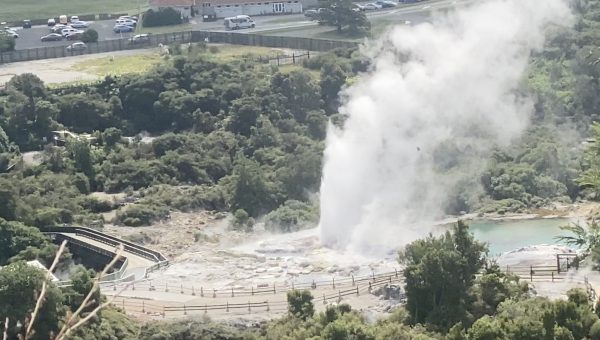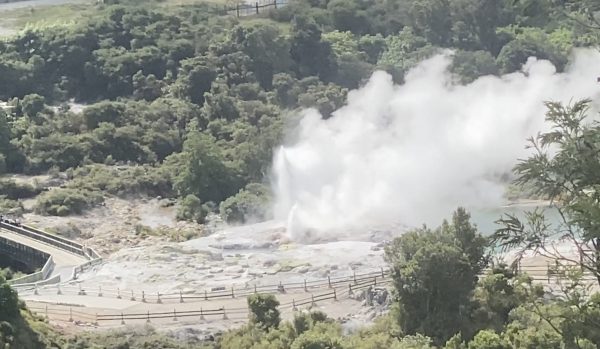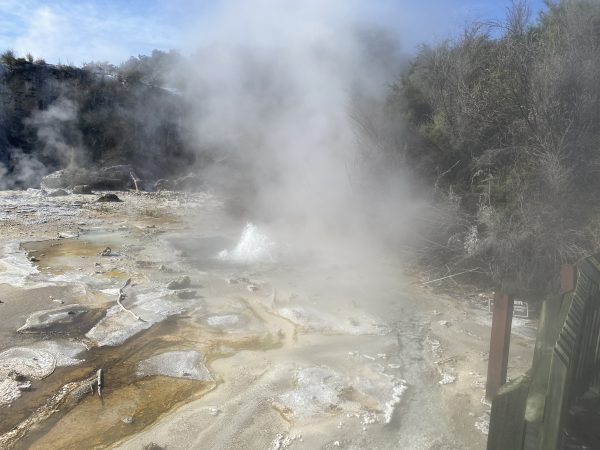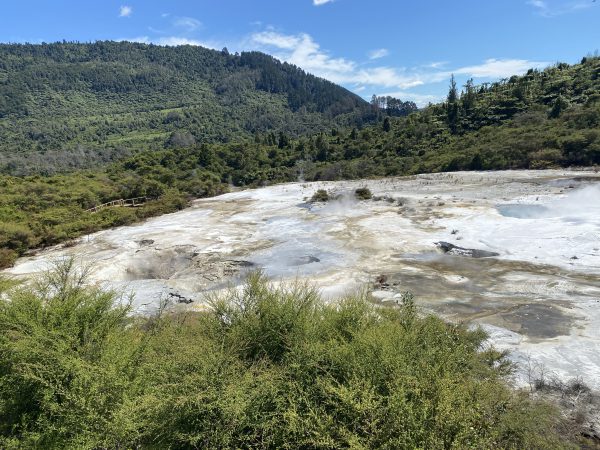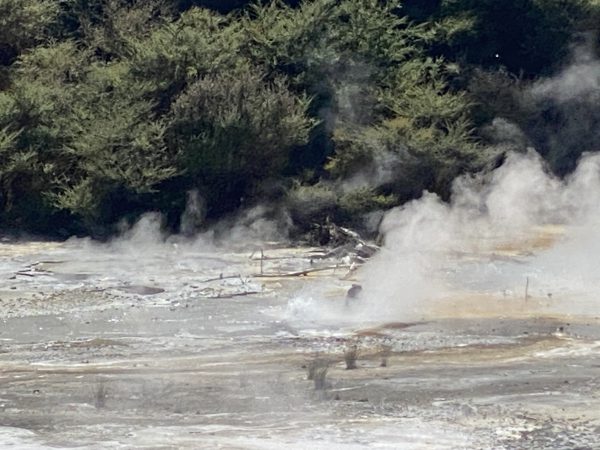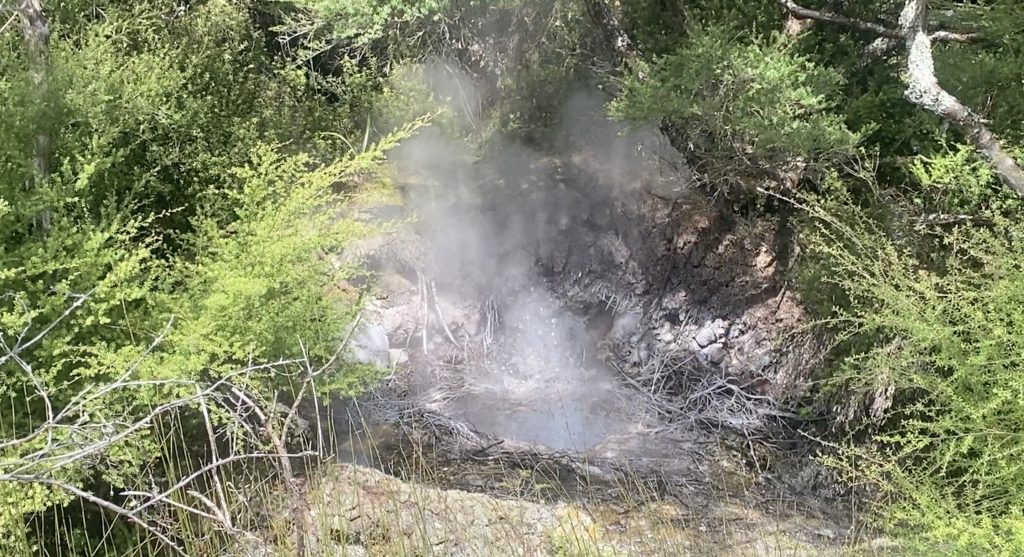Posted on
Category: New Zealand
Posted on
Posted on
Artist's Palette, Orakeikorako, New Zealand
Posted on
Waimangu Valley, New Zealand
Posted on
Steaming Cliffs at Rotomahana, Waimangu, New Zealand
Kayak tours are offered by Paddleboard Rotorua.
Posted on
Pohutu Geyser Eruptions, Whakarewarewa, New Zealand
Posted on
Mahanga Geyser, Whakarewarewa, New Zealand
Posted on
Waiotapu Mudpots, Waiotapu, New Zealand
Posted on
Te Manaroa, Waikite, New Zealand
Posted on
Kereru Geyser, Whakarewarewa (Te Puia), New Zealand
Posted on
Hoani, Tokaanu, New Zealand
Posted on
Taumatapuhipuhi, Tokaanu, New Zealand
Posted on
Observations for 2023 March 12
Visted the Rotorua lakeshore and the Government Gardens. Once again, most of the features were murky, acid-sulphate springs and formation. Whangapipiro Pool (aka Rachel Spring) was the one clear, alkaline boiling feature behind a rock wall across the street from the lawn bowling and croquet lawns.
On some maps I've seen a trail along the north side of Puarenga Stream north of Whakawerawera. Investigated it and found that other than one large boiling pool, it doesn't provide any better access or views to the features along the stream inside the village.
The afternoon was spent at the geyser overlook along the Pohaturoa Trail in the Whakawerawera Forest Preserve. From there, over a period of about three hours, saw multiple eruptions of all the features on Geyser Flat.
Pohutu seems to have had a short duration eruption, about 15 minutes long, followed by a short interval, about 36 minutes. That eruption was more normal for the last few days, lasting about 45 minutes with an interval of just under 1-1/2 hours. It's interesting that during the last few days, Pohutu was in eruption about half the time, no matter what the duration was.
Saw several series from Mahanga, and again they seemed to be different than previous days, in both length of series and in interval between series. One series was long, about 16 minutes, followed by 34 minutes of quiet. The next series was only a few weak splashes, and then inactivity for 15 minutes. That series duration was almost 20 minutes long, and Mahanga hadn't restarted by the time we left a half hour later.
Finally, we got to see two eruptions of Kereru. The first was a complete surprise, as usual. The second came about 100 minutes later, just as Pohutu was starting. So I should have gotten it on video, but unfortunately I was so zoomed in that the view was bouncing around and I was watching the geysers, not the little screen. So I didn't get much more than some nice still shots.
In any case, we have seen Kereru on four different days, and pairs of eruptions with intervals ranging from around 70 minutes to about two hours. I'd say that Kereru is quite active, or we got extremely lucky.
On the way back, we visited one last thermal feature. Deep in the forest of non-native California Redwoods is a small mudpot. It's probably one of the most unusual settings for a thermal feature that I've encountered.
Posted on
Observations for 2023 March 11
Today was much nicer than yesterday, so it was a day to get out and about. There's more than just geothermal areas in and around Rotorua, and we spent some time on them. But we also visited Tikitere (Hell's Gate) for a couple of hours.
It's sub-divided into several distinct thermal areas, two of which have trails in them. Walked all the trails for a couple of hours. It's another acid sulphate area with many large pools filled with gray water with areas of convection, and lots of sulferous ground. There were a couple of pools with water being thrown a couple of meters high.
At the entrance to the area, next to the bathing pools is a steam vent, which is probably an uncapped steam well. A nice, artificial fumarole.
We didn't visit it on our prior trip, and I doubt we will be visiting it again. Like seeing an eruption of Lady Knox, at least now we know what we are missing.
Posted on
Observations for 2023 March 10
A rainy day, heavy at times, but it got a bit sunny in the early afternoon, so we went to spend a couple of hours in Kuirau Park.
First stop was to take a look at Spring #721. This is the feature which erupted over 100 meters high for 15 minutes on a January Friday back in 2001. Now its just an opaque pool with some slight convection.
Visited the area along Tarewa Street, where several houses had to be abandoned when the springs they were built over reactivated. One of the springs is fairly large and clear and hot, which seems different in an area where most are opaque and acidic. Nearby is another hot feature, which is believe is #712, Parekohoru, that was boiling up about 30cm or so.
Kuirau Lake was steamy thanks to the high humidity from the rains. The boardwalk on the northeast side was fenced off. It looked like the lake might have risen just enough to start flooding and undermining the walkway.
The small spouters next to the Jaycee Thermal Monument seemed pretty much unchanged from the visit four years ago. The same could be said of most of the rest of the features.
After two hours, the rains started up again as we were leaving.
Posted on
Observations for 2023 March 09
Today we returned to the Whakarewarewa thermal area, but on the Maori village side. We got a late start because we misunderstood the types of tours offered. You can't see Korotiotio and Parekohoru on the Geothermal Walks self-guided tour, but need to take the Village Legacy Tour. But that also includes access to the Pohutu viewpoint, where we spent much of our time.
The view of the Geyser Flat, while not close, is still pretty good. You can see enough of Kereru to get an idea of what it is doing, and Mahanga is visible at the same time. We arrived there while Pohutu was active. It was probably early in the eruption of Pohutu, because it continued to erupt for half an hour. We saw the start of a Mahanga series which lasted about 12 minutes.
After 45 minutes or so, Te Tohu started, and almost immediately, we also got an eruption of Kereru. As in the other times we've see it erupt, it seemed to have been quiet before the eruption. Afterwards, it was having strong minors for the next hour or so.
Two hours later, an eruption of Pohutu had come and gone. There were three series of Mahanga eruptions, lasting from 9 to 14 minutes. Pohutu had been erupting for about 12 minutes, and it was three minutes short of two hours when we got to see a second Kereru eruption.
At that point, we took our Geothermal Walk. The area covered is large, with numerous hot pools with occasional mudpots and areas of what appear to be perpetual spouters. The underbrush is thick is many places, hiding features so much that you can hear them, but not see them.
Since we still had an hour before closing, we went back to the overlook, but were blocked out by some tours. By the time we got to the platform, it looked like Kereru was finishing an eruption. Over the next hour, it had many strong minors. Some of these would put up jets of water well above the higher Geyser Flat platform. If that was an eruption, then the interval was about 1-1/2 hour, which fits our previous experiences.
During that time watching the minors, we saw Mahanga end a series, then have another that was still going 19 minutes later, when we finally had to leave the area. At that time Pohutu was still about ten minutes away from another eruption.
Posted on
Observations for 2023 March 08
It was clear when we started the drive, but by the time we got to the junction with State Highway 35, there was fog. It got really thick as we approached the Waiotapu thermal area, and I expected it to clear after that, but it was foggy all the way to Orakeikorako.
We arrived just before a busload of tourists arrived, but got across the lake on the ferry well before they arrived in the thermal area. Over the next twenty minutes, the fog cleared, the air warmed and it was a bright and clear the rest of the day.
The first thing of interest I noted was that Bush Geyser was now visible from the trail. In our previous visit, I didn't even know about it despite it only being a couple of meters off the trail. But back then, it was hidden by think underbrush, which is characteristic of most of the thermal area. Not knowing how it behaves, I was under the assumpt that it was dormant since there was no evidence of any wash zone around the vent. That would prove to be a wrong assumption.
Within the first half hour, we saw eruptions of Cascade and Sapphire. We didn't stick around for intervals, but went onward and upward onto the next terrace. There we found Wairiri Geyser active. The previous visit, four years ago, it was a quiet, cool, brown pool. Now it was boiling and splashing up to a meter high, with copious discharge under the walkway.
Nearby were the new features which had appeared underneath the boardwalk. (Last year I discovered a paper in which a researcher went around finding areas of hot ground. One of the areas, years before the breakouts, was that exact area under the old boardwalk.) They look like they haven't erupted in a long time. Some gurgling could be heard from one of the vents, which was the extent of the activity. The vent closest to Wairiri, on the left, had runoff coated with slime running into it. The boardwalk itself had been replaced since last time, and the undergrowth was already starting to obliterate the old trail in places.
Artists Palette was disappointing. There was almost no water being discharged anywhere. Last visit there was a nice thermal waterfall behind Wairiri and flooding into Dreadnought Geyser. That was gone. All the features on the left, as seen from the overlook shelter were completely drained. Last visit they were full, boiling and featured several pool type geysers.
Feature #812 had been a thin jet perpetual spouter coming out of a broad pool. It was not erupting, and it's pool area looked damp at best. Later in the day we saw #812 erupting, It was much wider and more ragged, and was acting as a true geyser, but did not fill out the pool area. The water was confined to the central vent.
The sounds of an eruption were usually audible from the area to the right of Psyche's Bath, like four years ago. Still have no idea what is causing them.
The only activity that was new was from what I believe is vent #735. This was a perpetual spouter about a half meter high which would cycle up and down over the course of a minute or so, rising and falling abou 30 to 40 centimeters.
On the side of the boardwalk, opposite the terrace as one approaches the junctions and observation shelter is a large, hot pool that I don't remember from the previous visit. It may also have been a case of something being hidden by the underbrush.
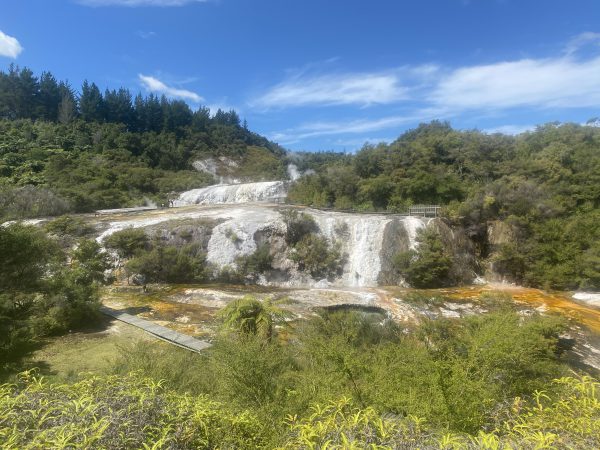
By this time we decided to concentrate on the Emerald Terrace features Sapphire and Cascade. At least there we would be seeing eruptions.There may have been other geysers active on Artists Palette, but we didn't want to spend the time to find out.
We got back and with a few minutes saw eruptions of both Sapphire and Cascade. We were able to infer that either we'd missed an eruption of Sapphire, or it was having shorter intervals than four years ago. As it turned out, Sapphire was having shorter intervals, consistently erupting every 35 to 40 minutes. Between major eruptions, every three minutes or so it would have a short minor eruption episode. At first these consisted of heavy, noisy steam, but as the interval progressed, these would turn into weak splashing lasting maybe 10 seconds. The start of the major eruption almost immediately appeared different and stronger compared to the minors.
The eruptions usually lasted about 1m30s to 1m45s, but some were as short as 1m16s and one eruption had some late splashes pushing the duration past two minutes.
Cascade was having longer intervals than our previous visit, consistently 19 to 20 minutes apart. Otherwise they seemed unchanged from four years ago. The start was sudden. My usual way of catching the start on video was to start recording just before 19 minute mark.
Early in the afternoon I finally got to see activity in Bush. This consisted of a lot of noise, and a single visible splash. Over the next 45 minutes I saw several such episodes, mostly noise but with a splash or two.
At one point, I saw steam visible behind the ridge to the west, where Kurapai should be. It lasted for at least ten minutes, and I didn't see any more steam there the rest of the visit.
As with the other thermal areas we visited, visitation seemed low, with only a few buses visible in the parking lot across the lake.
Then there was a noisy episode which lasted longer. It gradually changed to splashing, always within the crater rim and with almost no discharge. Some of the water droplet may have got about a meter above the rim.
We ended up seeing 16 eruptions of Cascade, and 8 eruptions of Sapphire. The last eruptions were the last possible ones before they area was closed.
We also got to see Pohutu in eruption as we drove past on our way to fuel up our car.

